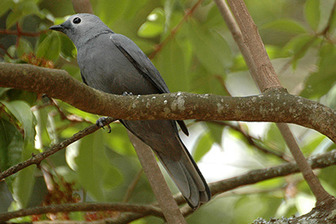Grey Cuckooshrike
Its natural habitats are subtropical or tropical moist lowland forests, subtropical or tropical moist montane forests, and subtropical or tropical dry shrubland.

Original source: Tom TarrantPermission(Reusing this file)Attribution ShareAlike 3.0
Author: Tom TarrantPermission(Reusing this file)Attribution ShareAlike 3.0
The Grey Cuckooshrike is classified as Least Concern. Does not qualify for a more at risk category. Widespread and abundant taxa are included in this category.
Distribution of Grey cuckooshrike in southern Africa, based on statistical smoothing of the records from first SA Bird Atlas Project (© Animal Demography unit, University of Cape Town; smoothing by Birgit Erni and Francesca Little). Colours range from dark blue (most common) through to yellow (least common). See here for the latest distribution from the SABAP2. More
picture of the Grey Cuckooshrike on page 705. The Grey Cuckooshrike belongs to the family of birds classified as Campephagidae. According to the Percy FitzPatrick Institute of African Ornithology the Grey Cuckooshrike is also known by these other names: Mountain Grey Cuckooshrike, African Grey Cuckooshrike. The map of the Kruger you see on this page shows the areas (coloured orange) where this bird has been identified. More
Cuckoo-shrike, Grey Cuckooshrike, Grey Cuckoo-shrike, Mountain Gray Cuckooshrike, Mountain Grey Cuckooshrike Spanish: Oruguero Gris, Oruguero Gris Africano Finnish: Afrikanharmaakäpinkäinen French: Echenilleur gris, Échenilleur gris Italian: Averla cuculo grigia, Coracina grigia africana Japanese: haiirooosanshoukui Japanese: ハイイロオオサンショウクイ Latin: Coracina caesia Dutch: Bosrupsvogel Norwegian: Grålarveeter Polish: kruczyna szara Portuguese: Lagarteiro-cinzento, Picanco cuco cinzento Slovak: húseniciarka sivá Swahili: Gude Kijivu Xhosa: Umsimpofu More
Wood-Owl, Grey Waxbill, Grey Cuckooshrike, Narina Trogon, African Emerald Cuckoo and Red-backed Mannikin can be found. 2. A few pairs of African Crowned Eagle breed in the gorge and the nest of one pair is visible from a path along the lip of the gorge. Take the path downstream towards the main gorge from the Kloof Falls picnic site, but keeping to the upper path. More
Family : Campephagidae
Genus : Coracina
Species : caesia
Authority : (Lichtenstein, 1823)

